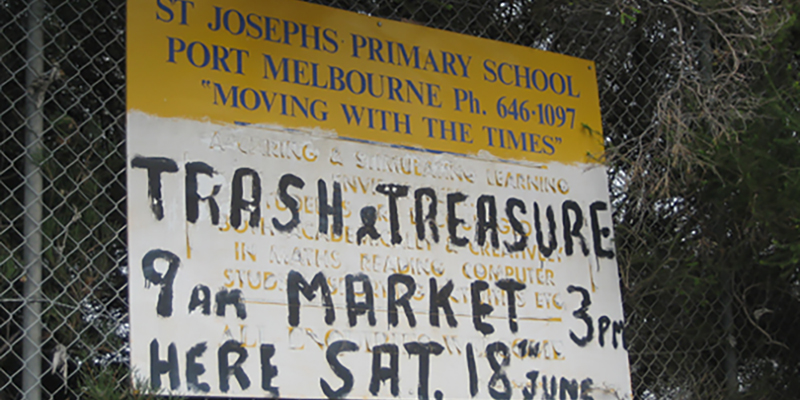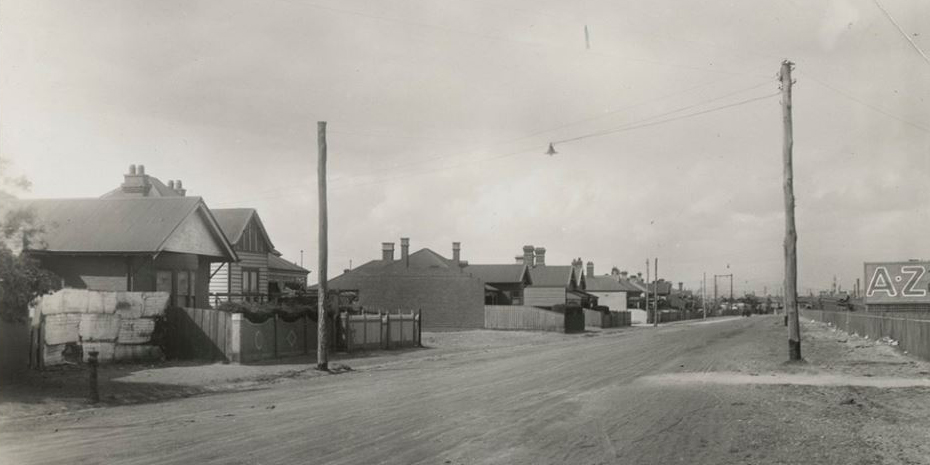Bismarck Street
by David Radcliffe
Around Port Melbourne there are streets, like Bain Street, that once existed but have since disappeared. There are many more streets whose name has been changed.
In April 1878, a cluster of intersecting streets in the south-western corner of the rapidly expanding Sandridge were gazetted as shown below.1 One of these was Bismarck Street.

Note the self-referential nature of descriptions; Albert goes from Bismarck to Farrell and Bismarck goes from Railway Crescent to Clark and Clark goes from Bismarck to Farrell.
This map from 1878 indicates the new streets but without names.

In fact, the Crown Land between Clark and Ross Streets from Farrell to Bismarck Street had been surveyed and subdivided into one-acre allotments (with a few smaller ones near Bismarck St.) and sold off in 1868 and 1869. Subsequently, these large allotments were subdivided as building blocks predominately during the boom of the 1880s, creating the tightly packed neighbourhood around Albert and Alfred Streets.
In 1891, Bismarck Street was renamed Poolman Street, a victim of the “street-naming orgy” whereby many Port Melbourne mayors were honoured by having streets named after them.2 During the 13 years it existed, no one ever lived on Bismarck Street. As late as 1894, there were still no houses built on the newly minted Poolman Street. The first house only appeared in the early 1900s and by 1911 the frontage between Nelson and Alfred Streets was completely settled.

One of the few mentions of the short-lived Bismarck Street is a rambling letter to the editor of the Standard in 1884.3 The letter writer begins by commenting on the upcoming appointment of several people as a Justice of the Peace (JP). The letter continues ….
“….. I happened to find myself in Bismarck Street. Now Mr Editor, I must really digress again to remark what a disgustingly short name Bismarck is. In my country the streets have good long sounding names – how much better “D’ye O. Julius Caesar von Wiseman von Bismarck Street” would sound. Now, study the difference of the two names on paper, and no doubt you will agree with me the latter is more euphonious and highly appropriate; for Bismarck is a venerable Julius Caesar for power and certainly a wise man, in that like myself, whilst looking after the affairs of the state or public, has not forgotten to see after (No. 1) himself. Well to go on – whilst rambling through the aforementioned shortest street in the Borough, the happy thought occurred that in exchange for my patronage and odd pence you would feel bound to make out a good case for at least one of the would be JPs ….”
(The letter was signed “Wait a While”. The editor stated that they published the letter in the hope that the writer would “ponder over the nonsense it contains and in future avoid committing such stupidity to paper”.)
Just as you should not believe everything that is published in the press, or online, so too you need to be cautious when using historical maps to draw conclusions. The following extract from a Works Department map dated 1914 indicates that Bismarck Street still existed in Port Melbourne at the start of the First World War.

The war evoked widespread anti-German hysteria. Across the nation, many streets named Bismarck, and others with German associations, were renamed in a flurry of patriotic fervour.4 It was a difficult time for people who had emigrated from Germany, even if they had become naturalised Australians. Ironically, some of those who had opposed the Kaiser, and left Germany, found themselves unwelcome, alienated and even interned in their adopted country. This was the sad fate of the Falkenreich family of Port Melbourne.
The name we give to a place, matters. Names can honour, but names can also divide.
1 Victorian Government Gazette, No. 30, April 5, 1878, p. 769.
2 U’ren, Nancy. and Turnbull, Noel (1983). A History of Port Melbourne, Oxford University Press, p. 174.
3 1884 ‘CORRESPONDENCE.’, Standard (Port Melbourne, Vic. : 1884 – 1914), 14 June, p. 3. , viewed 02 Feb 2022, http://nla.gov.au/nla.news-article164932870
4 1916 ‘STREET NOMENCLATURE.’, The Age (Melbourne, Vic. : 1854 – 1954), 8 February, p. 8. , viewed 02 Feb 2022, http://nla.gov.au/nla.news-article155123489



1 Comments
Rod Atkins
Hi Team,
I am seeking your help on some very old information from just before the WW1.
City Road was renamed from Sandridge Road. When did this change take place? I assume it was after 1884.
Varley Bros Printers and bookbinders was at the St Kilda Road end of this road in a large brick building which may have been absorbed into Australia Paper? I am finding it very hard to find any information about this company at this address.
Thanks in advance. Rod. Atkins.